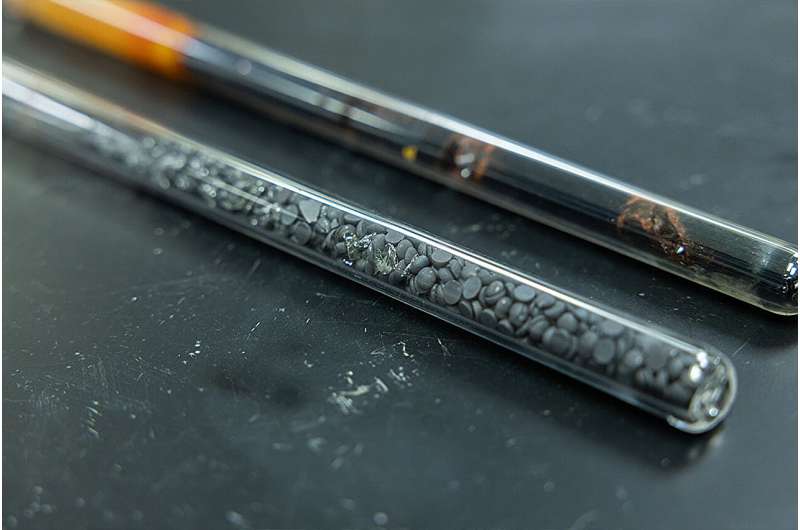This article has been reviewed according to Science X's editorial process and policies. Editors have highlighted the following attributes while ensuring the content's credibility:
fact-checked
trusted source
proofread
'Self-healing' glass: Study shows microscopic defects are reversed when exposed to gamma radiation

Self-healing glass may sound like a science fiction concept, but new research from the University of Central Florida demonstrates it's much closer to reality.
In a new study published in the journal Materials Research Society Bulletin, UCF College of Optics and Photonics (CREOL) Pegasus Professor Kathleen Richardson and colleagues from Clemson University and the Massachusetts Institute of Technology studied the incredible self-healing capabilities of a specialized chalcogenide glass after it was exposed to gamma radiation.
Chalcogenide glasses are comprised of chalcogen elements—sulfur, selenium, and tellurium—alloyed with elements like germanium or arsenic to create optical glass materials that may be applied to sensors or infrared lenses.
As part of shared research between the universities, Richardson, who is director of UCF's Glass Processing and Characterization Laboratory (GPCL), and her co-investigators observed this unique transformation while testing a specific chalcogenide glass made of germanium, antimony and sulfur for use in a satellite's circuitry system. When exposed to gamma radiation similar to what may be encountered in space, the glass developed microscopic defects that later were repaired over time in a room temperature environment.
The self-healing glass could be useful in devices or instruments that may be exposed to extreme environments where gamma radiation may be prevalent, such as space or radioactive facilities. The research also provides foundational knowledge of the microscopic origins of the self-healing process for a wider variety of chalcogenide glasses.
For the study, UCF researchers measured the quantities of the raw elemental material and fabricated the chalcogenide glass, says Richardson.
The process must be precise, and the UCF lab is highly specialized to ensure the glass isn't exposed to moisture, oxygen or other contaminants, she says.
"We put the materials in a furnace where we can melt them into a glassy state," Richardson says. "Once it's melted, the glass is then broken out of these tubes. This particular program sent the melted glasses to MIT where they made thin films out of these materials."
The desire to harness this specialized glass for use in infrared systems has risen as traditional materials have become scarce and prohibitively expensive, she says.
"People are increasingly looking at glasses that have similar optical transparency to crystals such as germanium that can be engineered for their composition and properties for use in applications where germanium may be used," Richardson says. "These glasses are seeing more and more use in systems where the community is looking for alternatives to some of the crystalline solutions that have historically been used before."
These glasses are distinct from conventional glasses, such as in windows or eyeglasses, she says.
"These glasses exclude oxygen, and that's what makes them special for the infrared," Richardson says. "These are made of elements on the far-right side of the periodic table. When they bond together, they make very infrared transparent materials but with very large atoms and weak bonds."

The notion of "self-healing" is derived from the ability of these bonds to be distorted when exposed to radiation, she says.
"Because they're big atoms and weak bonds, over time, these bonds can relax back and reform from this distorted arrangement, and therefore heal," Richardson says. "So, the concept of self-healing glass is that when our experiments get exposed to high energy radiation, these bonds are distorted or broken. Over time, room temperature is enough to heal these bonds so that the structures can reform themselves."
In addition to the vast network of collaborators, she worked with former UCF colleague and research scientist Myungkoo Kang, who analyzed the optical properties of the materials before and after radiation exposure.
Kang, who recently became an assistant professor of ceramic engineering at Alfred University's Inamori School of Engineering, was grateful for the experience he gained at UCF.
"Through the training, I became a PI, co-PI, or subcontractor of numerous federally and industrially funded multi-university research programs," he says. "Experiencing such upper-level scholarly activities eventually set me ready to become faculty, and I embarked on a new academic journey."
The knowledge gained from this self-healing glass experiment paves the way for future research opportunities to explore the properties and uses for other potentially self-healing chalcogenide glasses, Kang says.
"Moving forward, my new research group aims to develop irradiation-induced novel ceramics along with in-situ microstructural and optical metrology methods as a route toward the realization of ultra-fast lightweight optical platforms," he says. "My research under the unifying theme of irradiation effects in chalcogenide ceramics has yielded such an impactful takeaway."
Kang likens the materials of chalcogenide glasses he and Richardson study to a "soup" where sulfur, selenium and tellurium serves as a base. Germanium, arsenic and antimony are "spices" to be blended—or alloyed—to adjust the properties of the glass.
The particular glass that Richardson, Kang and the other scientists had concocted and tested proved that its gamma-induced changes and post-gamma recovery are consistent and reproducible, Kang says.
"This finding strongly indicates that the material system can be deployed as a robust, reversible radiation sensor in extreme environments such as space and ground-based radioactive facilities where gamma ray is characteristically abundant," he says.
Kang says one of the most gratifying parts of the research—aside from the promising results—was the collaboration and coordination across universities.
"Samples were shipped back and forth between various locations, and it would not have been possible without our team members' commitment and passion," he says. "This work is a result of almost five-year-long team effort. I am happy to see that this work finally sees the light of day."
More information: Myungkoo Kang et al, Self-healing mechanisms for Ge–Sb–S chalcogenide glasses upon gamma irradiation, MRS Bulletin (2024). DOI: 10.1557/s43577-024-00693-x
Provided by University of Central Florida



















